A guide to effective bird scaring kits for farmers
New technology for farmers with the age-old problem of scaring birds off crops are constantly hitting the market.
From lasers, to acoustic systems, to inflatable scarecrows, to kites, we look at some of the most effective bird scarers available to help send the pigeons packing.
Best of all, these new pieces of kit promise to stop the pests getting used to farmers’ measures.
See also: Worcestershire farmer designs bang-free birdscarer
And we certainly need them because the flocks of pigeons, starlings, gulls, crows, rooks and geese that descend on our fields, silage clamps and feeding barriers aren’t going to go away any time soon.
In fact, their sheer numbers can be pretty frightening. A female pigeon can rear 80 young in its three-year lifetime; a starling can produce four to nine young a year and on average lives for three years; and gulls live up to 30 years and produce two to four young every year.
Depressing? Yes, but next time it’s a bad pigeon year, farmers will have some new and improved technologies. Here’s what’s available:
- A high-tech Agrilaser Autonomic fixed laser
- Several makes of handheld laser capable of disrupting birds at a distance of 1,000m
- Six or more improved acoustic systems for field use
- Equipment for deterring starlings, rooks and gulls near feed barriers
- The latest bangers, rockets, kites and scarers
Lasers
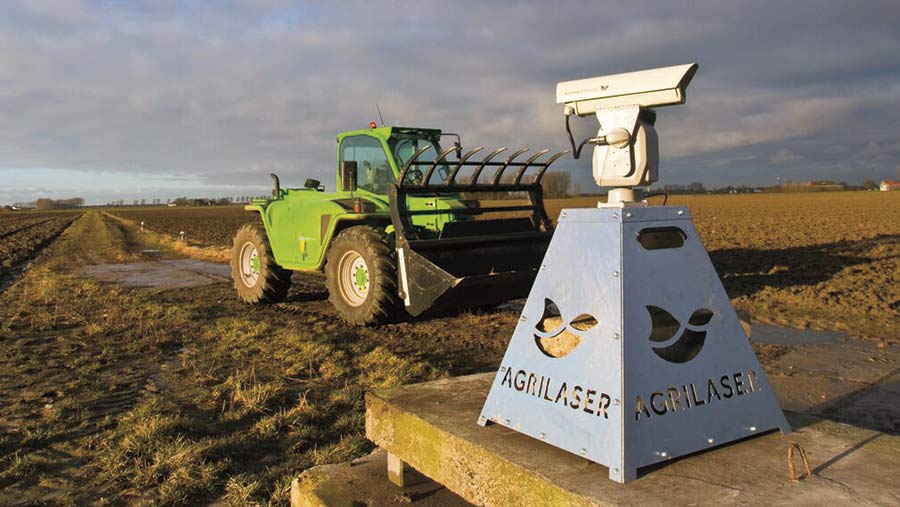
The strobing Agrilaser beam constantly moves to cover the ground © PestFix
It’s not just farmers that have trouble with masses of birds descending on their land. Airports, oil drilling platforms, commercial fishing boats, factory roofs, solar panels, parks and residential areas all suffer. Cleaning up all this goo is difficult and unpleasant.
In the past, the only answer was to cull the birds, which is difficult, expensive and upsets locals.
However, technology is finally coming in the form of lasers – not to kill the birds, but to use their dislike of bright lights against them.
It’s been known for decades that birds are affected by intense light and floodlights have been widely used to trap them. Pulsing lights have also been employed to deter them from entering aircraft hangers.
However, it needed the arrival of high-tech lasers and computerisation to produce effective, safe and weatherproof equipment.
What’s happened now?
Dutch researchers at Delft University of Technology built the first commercial prototypes about six years ago. The EU, meanwhile, contributed £1.5m to support the research. The breakthrough was to achieve a laser beam that was constantly moving to cover the ground.
The strobing Agrilaser beam is akin to the light hitting a glitterball at an old-style dance hall. It shines on just one small bit of the ground for a fraction of a second or so – enough to make the birds fly away – but avoids damaging the eyes of humans, farm animals or pets.
The first units went on sale earlier last year, from a Dutch company called Bird Control Group, and there are now reckoned to be 6,000 units (in all sectors) working around the world.
UK experience
Several UK organisations have been working with the technology. Two years ago Stockbridge Technology Centre, Cranfield University and high-tech GPS company Manterra used one of these strobing lasers to scare off troublesome birds from veg crops.
In a study designed to investigate soil mapping and fertiliser application, 165,000 pointed cabbages were transplanted at a North Yorkshire farm.
Normally the crop would be netted after transplanting, but the project team set up an Agrilaser powered by a solar panel and 12V battery. The result was that this novel piece of technology appeared to have effectively protected the cabbages.
What next?
Several UK organisations around the UK are testing the Agrilaser Autonomic technology to see how it works with real-life crops and conditions.
The latest of these was set up in June 2017 by a team at Liverpool John Moores University and the Game & Wildlife Conservation Trust in the field at Shotwick, Cheshire. They have been testing the practical issues of having the laser system operating completely autonomously around the clock.
The system is configured with a solar panel and battery option, which means that it can operate without mains connection for extended periods. The ongoing trial is monitoring the system and looking at the effect on nearby livestock.
It is being monitored by motion-activated trail cameras and footage is reviewed weekly by the team. A second test site at Cheshire Wildlife Trust’s Bickley Hall will test how the system will cope with a wider variety of pest species and larger areas of land.
Is there a danger that the birds will get used to the lasers?
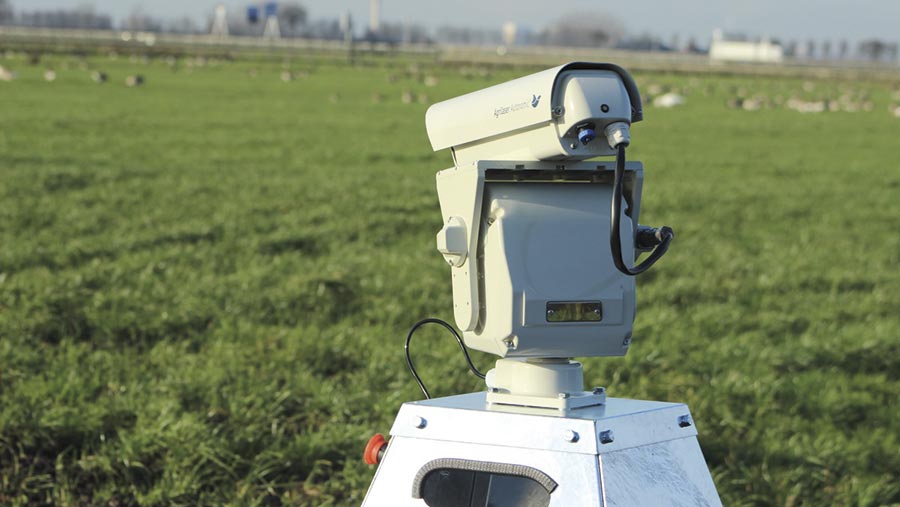
© PestFix
It seems not, since they hate bright lights, but it might be too soon to be sure. A test on rabbits in a field with the Agrilaser sadly produced only a 25% reduction in numbers.
What kit is available now?
The Agrilaser Autonomic is sold by West Sussex firm company Pestfix. There are two models – the mains-powered VD374 AC and the battery-powered VD374 DC.
The starting price is £10,000 and there are now about 100 units in the UK.
However, only 10-15% of these have been bought by farmers – most have gone to places like airports and oil rigs.
One obvious reason for that low figure in agriculture is that leaving a highly visible £10,000 unit in the middle of a field – however well anchored – is always in danger of being nicked by one of our light-fingered rural brethren. The good news is that there are now several hand-held lasers on the market with a starting price of £200.
How bright is the laser beam?
That depends on the existing light level. Not surprisingly, the darker it is, the further the laser beam penetrates.
The maximum range of the Agrilaser Autonomic in low light is an amazing 5,000m, in medium light it is 2,500m and in bright light 1,000m. The Autonomic’s laser can also rotate through 350deg (side to side) and 120deg (up and down).
How effective are they?
It’s still early days but these laser systems are already showing their worth, whether they are fixed or hand-held. For big producers of high-value crops, this technology is bringing lots of benefits.
In Oregon, USA, for instance, one large producer with 70ha of blueberries reckons he saved $75,000 (£56,000) in one year by using his Agrilaser Autonomic to deter American robins, European starlings and blackbirds.
US farmers with feedlots say they have been driven mad by the sheer number of starlings feasting on their maize silage. One Idaho dairy farmer said that losses of feed were causing him losses of more than £100,000. Buying an Agrilaser to zap them apparently did the trick.
Closer to home, Daniel Hoeberichts at Orchard Eggs at Forest Row in East Sussex was very worried about bird flu getting into his substantial chicken farm.
He considered setting up nets around the farm to prevent contact with wild birds but the plan wasn’t feasible. Instead he has been using an Agrilaser Autonomic since January 2017 and says the system has worked brilliantly.
The kit – lasers
Agriforce Laser birdscarer
Range in darkness: 500m
Suitable against pigeons, gulls, crows, rooks and gulls
Cost: £265
Laser Bird ND-100
Range: 1000-2,000m
Battery life: 6hr
Cost: £183
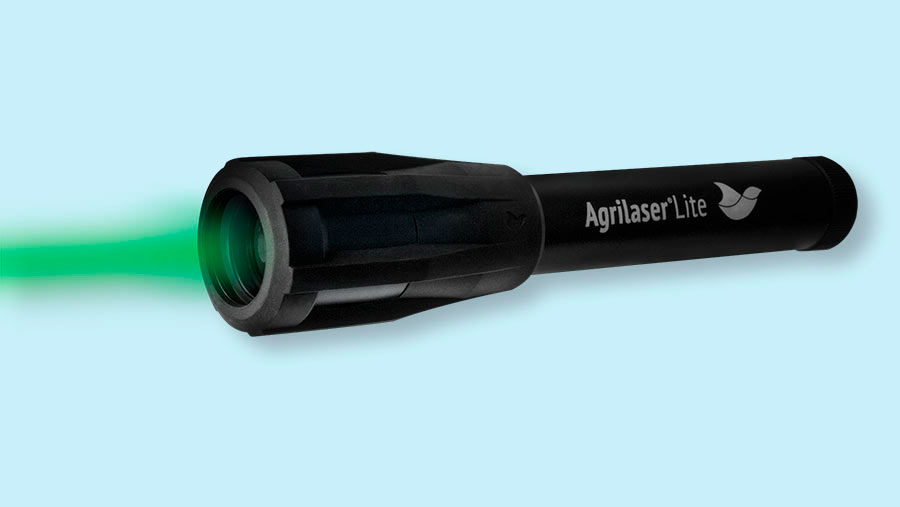
Pestfix Agrilaser Lite portable
Pestfix Agrilaser Lite portable
Intended to be used in dairy sheds
Range: up to 1,000m (night) and 200m (daylight)
Battery life: up to 150 minutes
Weight: 180g
Cost: £249
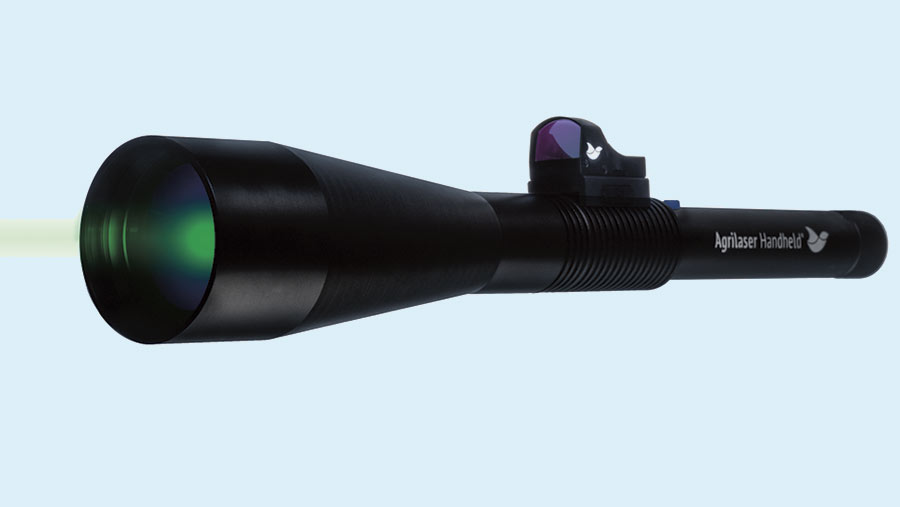
Pestfix Agrilaser Handheld
Pestfix Agrilaser Handheld
Range: up to 2,500m
Model 100: £600 for buildings/yards
Model 200: £1,152 for crops
Model 500: £1,842 for crops

Pestfix Agrilaser Autonomic (static)
Pestfix Agrilaser Autonomic (static)
Max range: 2,000m and can turn through 350deg plus 60deg of vertical movement
AC or solar powered
Weight: 10kg
The machine can be bought outright or on a three- to 12-month lease
Can protect 12sq km from a single point
Starting price: £10,000
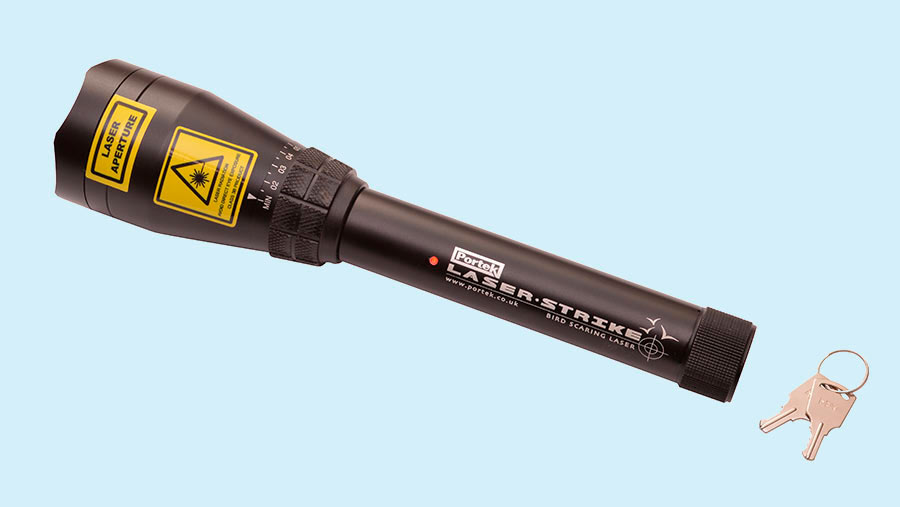
Portek Laserstrike birdscarer
Portek
£440 Laserstrike birdscarer, which can scare and clear birds at distances of 600m and be used in buildings
High-power laser systems – take care
With several makes of laser birdscarer now on the market (and prices coming down) it’s worth bearing in mind that you should keep kit like this well away from children.
The Agriliser Autonomic uses a beam that is safe because it stays only momentarily in one place, however pointing a handheld laser into someone’s eye can cause damage.
Also, since 2010, a law has been introduced to discourage people shining handheld lasers at aircraft. If they catch you, expect a custodial sentence.
Lasers give pigeons a big shock
Essex arable farmer Nick Cousins tried APM’s £270 Agriforce laser birdscarer, which claims to give a range from 100-500m. He wasn’t initially impressed, but is now pretty taken with the technology.
“The first time I used it was on a sunny day in December and I was a bit underwhelmed,” he says. “But the second time I used it on a typical winter dull day it worked really well and the pigeons all flew away.”
“In winter, flocks of pigeons will rest up in the trees and hedge lines around the oilseed rape fields, just waiting for you to turn your back.
“Flushing them out and away is as important as getting them out of the crop. The laser seemed particularly effective at this, and even two fields away. It clears rooks too.”
“I am still worried about habituation but so far they don’t seem to have got used to the bright light at all”.
“You’d still need to use a banger or a rocket every so often, but the laser could certainly cut your costs in the long run. Also, it’s very satisfying to use the laser and there’s no noise involved at all.”
“We have a couple of footpaths along fields, so you have to be careful about not accidentally shining the beam at walkers. Also, the laser may not be quite as effective when the crop gets higher.”
“The rechargeable battery does wear out quite quickly if you’re using the laser a lot, but the makers supply a second battery and it only takes a few seconds to swap them over.”
“The best thing of all is that I can cover 100 acres in five or 10 minutes, and the job’s done, but then I don’t have any sloping ground for the birds to hide away.”
Other (non-laser) pest kit
Agricultural Supply Services (Acoustic)
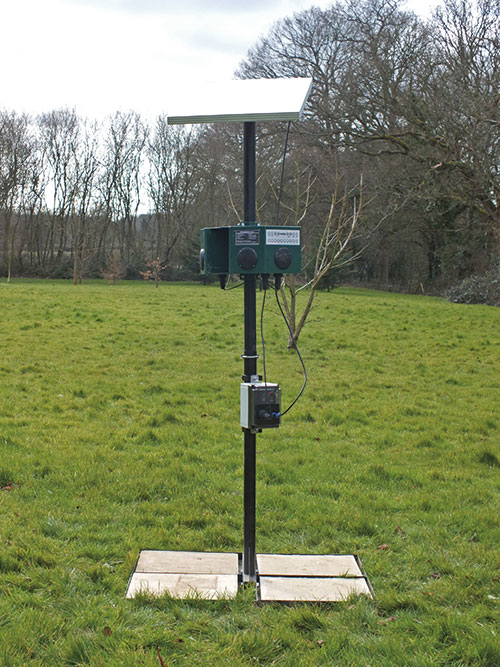
Gloucester company Agricultural Supply Services offers three models.
The Scarecrow Compact uses bird distress calls that claim to create an environment that appears hostile to birds but perfectly normal to humans and other animals.
Different distress calls can be programmed separately or together and different calls are aimed at pigeons (typically on rape and up to one-and-a-half miles away), crows, rooks and starlings (typically in dairy/livestock buildings and on silage clamps) and gulls.
Compact 180 costs £590 and covers 180deg. You can add a slave unit to cover 360deg for an extra £320.
Solar kit costs £750. 50/50 40% pigeons, starlings, geese crows.
Allsop Helikite
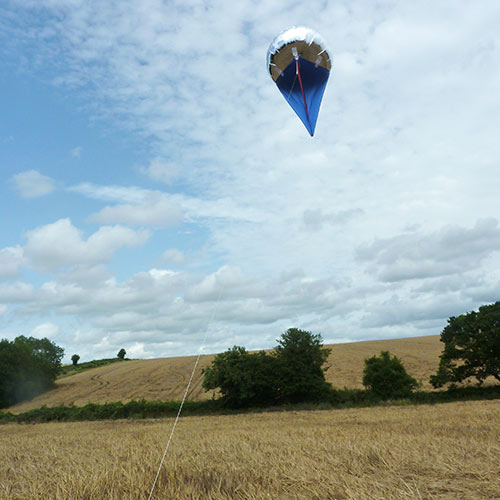
Allsop Helikite
Hampshire-based Allsop’s Helikites have been around a while but are still popular for scaring pigeons. A 7m Pro Hawk Combi costs £89.50 and an aluminium Peregrine Pro Hawk kite combination costs £145.
Meanwhile, a lightweight Helikite costs £110 and a Vigilante Helikite costs £125. A new model on offer is a 6.25m aluminium pole version of the Peregrine Hawk kite. The aluminium poles are said to be virtually indestructible.
It costs £145.
Astwell Augers
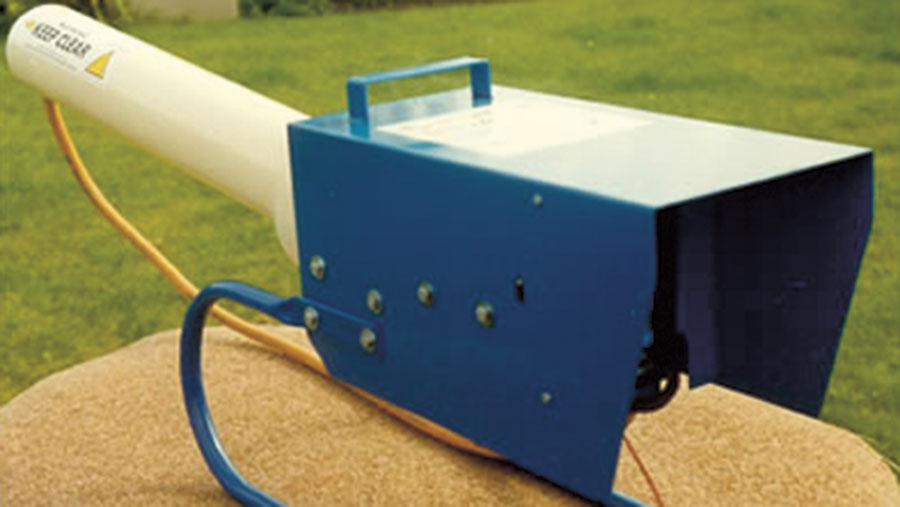
Astwell Augers Selectabang
Northamptonshire manufacturer Astwell’s Selectabang electronic birdscarer has selectable one to four bang operation, one- to 100-minute frequency, one- to five-hours dawn delay, photocell control twin solenoids for extra safety, low battery indicator and all-weather conditions.
The price is £340.
Bird Gard
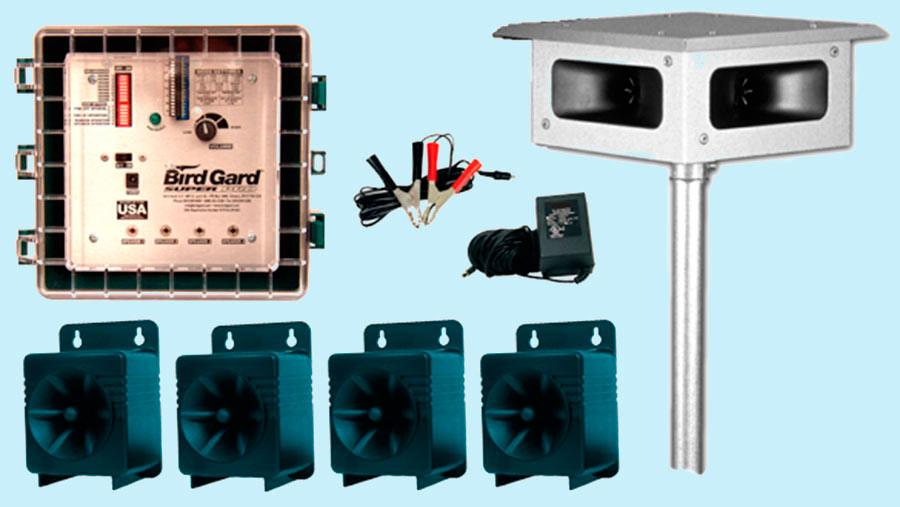
Bird Gard
Irish maker Bird Gard has four electronic scarers. Bird Gard Pro is the smallest model and protects up to 1.5 acres, the Pro Plus model protects up to 3 acres and the Super Pro protects up to 6 acres. The SuperPro PA4 is aimed at special applications.
Prices start at £325.
Clarretts

The Scarey Man birdscarer
Designed by a Cambridgeshire farmer, the 5ft 6in Scary Man birdscarer is one of the more unusual designs on the market and has been popular since it first appeared in 1984.
Essentially, it’s an inflatable orange scarecrow that rears up at 18-minute intervals for 25 seconds to surprise and shock the pigeons. Power comes from a 12V battery and there are several timer interval options.
The cost for a basic model is £320.
Fairbang Birdscarers
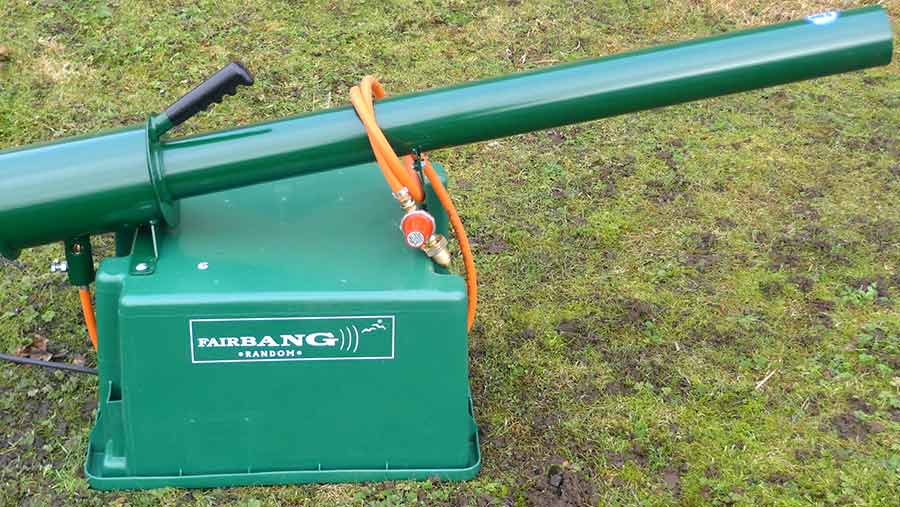
Fairbang birdscarer
Fairbang has been making birdscarers for 25 years and has sold 10,000. There are two models: the Single for £250 and Multi for £295. Features include multi bangs, random bangs, random and preset times, dawn delay and test switch.
Martin Lishman
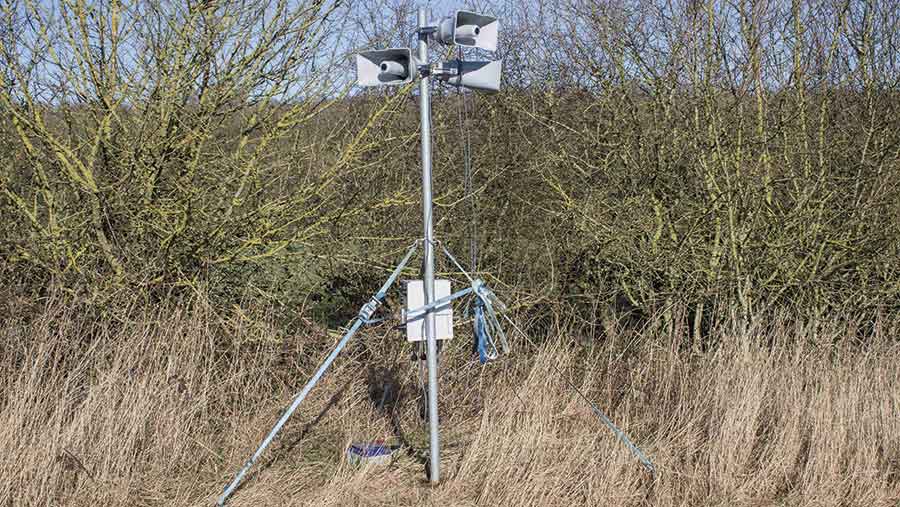
Martin Lishman’s Scarecrow B.I.R.D system
Lincolnshire company Martin Lishman offers its Scarecrow B.I.R.D system, which broadcasts 10 different distress calls through three loudspeaker channels and creates an environment that is hostile to birds.
Pigeons, rooks, jackdaws, crows and gulls are affected and a built-in remote light sensor gives dawn-to-dusk operation. Batteries last for several weeks.
The system can select single or multiple calls, plus automatic random playback and a selection of Normal (random up to 45 minutes), Re-enforce (random from 10 to 30 minutes) or Severe (randomly up to five to 15 minutes).
The system is aimed at pigeons in cereals and brassicas, crows in cereals and starlings in dairy units and on silage.
The company says that the battery can last for several weeks and is fully waterproof.
The price is £1,500.
Martley
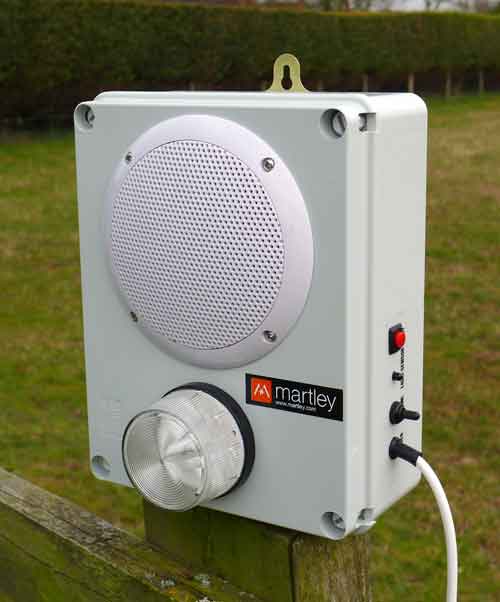
Martley’s Pestoff PR1000 Predator birdscarer
Worcester company Pestoff PR1000 Predator birdscarer. It has 10 preset sounds and costs £289.
BS6 indoor starling scarer. The speakers can be suspended or wall-mounted facing each other with a 25m cable between them.
A solar panel to keep the battery charged costs £50.
Michael Williams
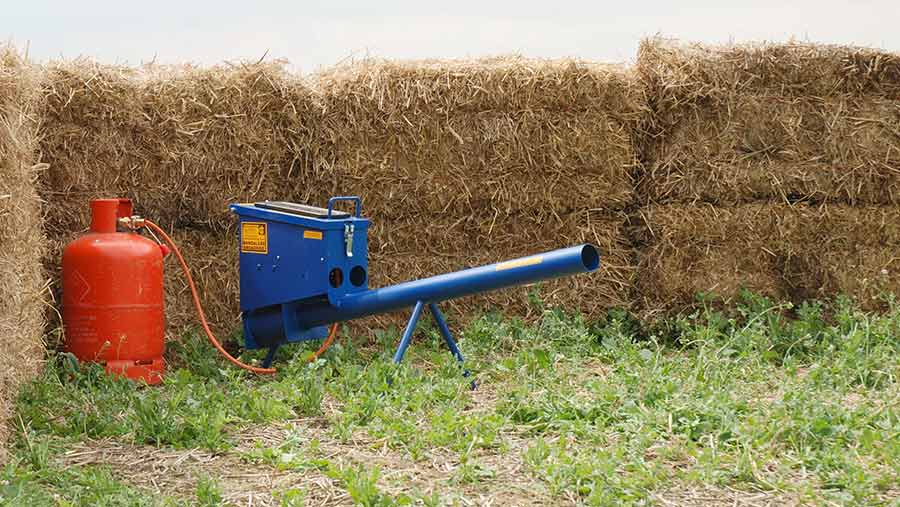
Michael William’s Bangalore Broadside birdscarer
Cambridgeshire company has been making its Bangalore Broadside birdscarers for 35 years. Its latest model has a solar panel to keep the internal battery topped up (and no need for a heavy car battery), plus a test-fire button.
Prices start at £340.
No More Birds
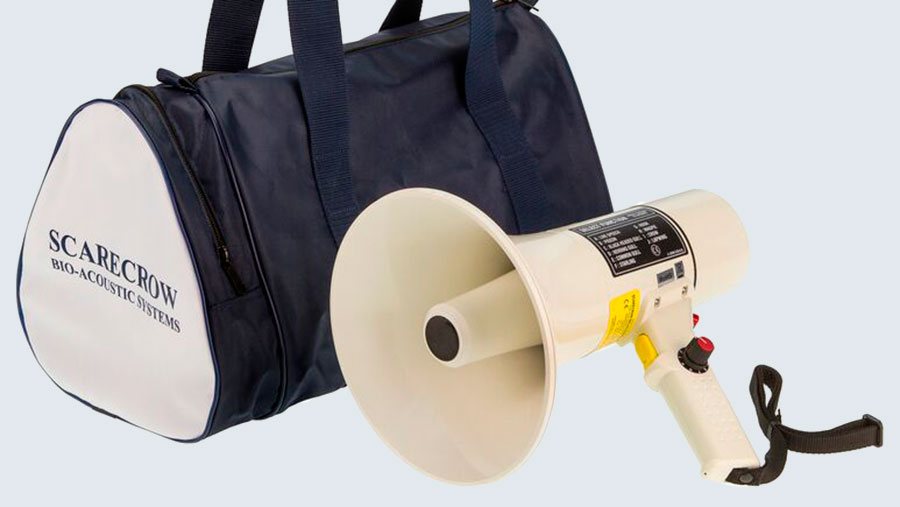
The Scarecrow Patrol Two
West Sussex firm offers the handheld Scarecrow Patrol 2. Effective operating distance – up to 350m. Battery life is 36 hours/120 days. Price is £965.
Scarecrow 180 System costs £619. It covers 1000sq/m or 2500sq/m with an additional speaker and is mains powered.
Peaceful Pyramid
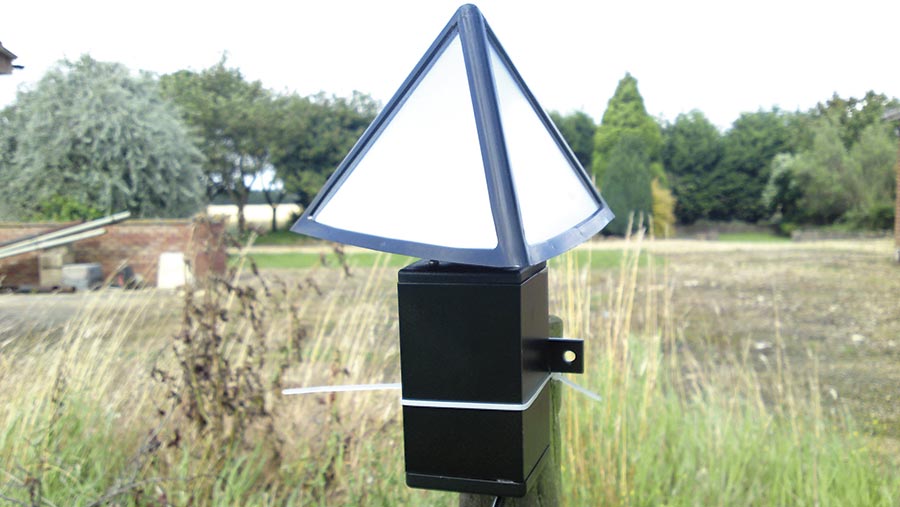
The Peaceful Pyramid
The unusual-looking Peaceful Pyramid from Suton, Norfolk, with its reflecting surfaces, has been selling for some years. Power from a 12V battery keeps it spinning and a light sensor turns it off at night. The G1 ground model costs £179 and there’s a post-mounted version, too.
Portek

Portek BirdYess
Wrexham company Portek sells the portable £294 BirdYell birdscarer. It’s not waterproof but is said to be ideal for use in farm buildings, grainstores and cattle yards.
Sounds available include starling, crow, goose, gull, wolf and a shotgun sound. It weighs 7.7kg and runs on a 12V car battery or 10 AA batteries. It’s not waterproof but OK in dusty conditions.
Portek also sells the £300 Scatterbird MK3 gas-powered birdscarer, birdscaring rockets, banger ropes and wind-driven birdscarers.
Scare’m

Scare’m Delta kite
Essex company Scare’m makes the Scare’m Delta kite (£20), the Hawk Kite (£40), the Scare’m XL (£80) and the Vari-scary gas cannon (£320). Plus the Scare’m Eyes Balloon (£20).
Scaringbirds
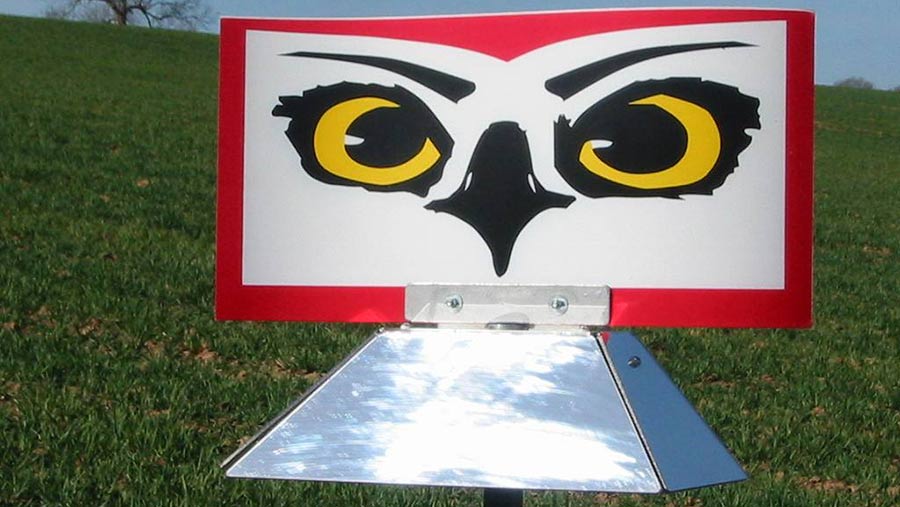
The Flashing Hawkeye windpowered-scarer
Shropshire company Scaringbirds offers a range of bird deterrents, including the Wailer, which uses audible and ultrasonic sounds to protect areas up to 12ha from a 12V battery.
The sounds go from speaker to speaker to upset the birds. Other options include the Wailer, Maxi Wailer (for general purpose use) and Midi Wailer (for smaller acreages) plus Birdbuzzer for cattle yards and silage clamps. The company also offers Flashing Hawkeye wind-powered scarers.
SMP Robotics

SMP Robotics
Wondering whether there are any completely robotic vehicles coming on the market? Californian manufacturer SMP Robotics now offers three types of bird deterrent.
All use battery power to get around the field but users have a choice of propane banger, bio-acoustic sound system and motion laser.
They automatically return to base before their batteries run out, so shouldn’t be left stranded. Maximum range is 18 miles, typical speed is 3mph and ground clearance is 180mm.
Costs haven’t been disclosed yet and there isn’t a UK importer. However, the machine was on show at the Milipol security event at Paris a few weeks ago.
Acoustic systems – dos and don’ts
- These units can be used in a 100-acre field, however you do need to move them regularly
- Leaving them like a banger in the same place is the worst thing you can do
- Flat land may need a higher setting, while a dairy would usually be at a lower noise level
- Don’t set the volume high without moving the unit – the birds will get used to the sound
- Selecting several different calls at the same time can work well, so even if the problem is pigeons, select the rook, jackdaw and crow randomly as well. All three crow species will predate the young of pigeons, so this gives added pressure to the pigeons to move.
- Adding the bird of prey call will add an extra dimension to any bird control situation
- For livestock farms and dairies, set up the unit about 100m from the silage pit
- In trials in open land, you should be able to get good control over a radius of 300m in an arc of 180deg
- Birds’ distress calls have the greatest effect if they appear to be coming from above the birds. If you can fix the speakers on a pole, the birds should lift from the fields.

